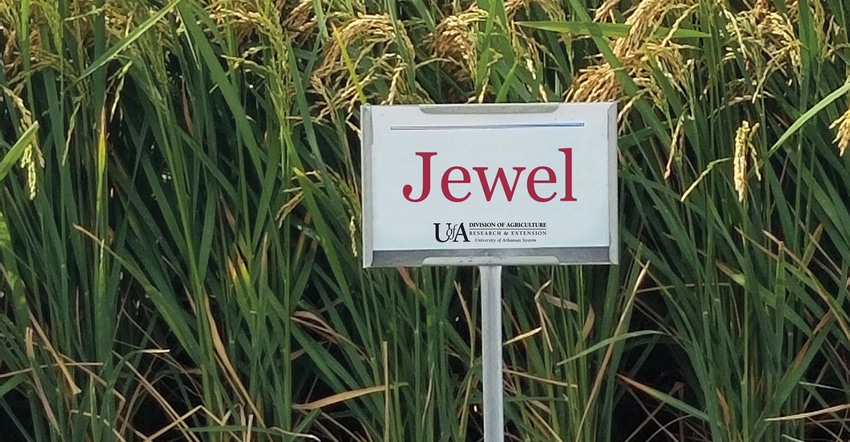
Jewel, a new rice variety from Arkansas, is a high-yielding variety with a good cook type and blast resistance.
Karen Moldenhauer, a professor and rice breeder for the Arkansas Agricultural Experiment Station, is one of the rice breeders for the new variety. The rice breeding program is based on the Rice Research and Extension Center near Stuttgart, Ark.
"This is the first year Jewel, a mid-season, long-grain rice cultivar, is being used as a foundation seed for growers," Moldenhauer said. "This will be the first time we get feedback on how it does in an on-farm location as opposed to the trials, which were spread all over the state. In the on-farm tests, which are the Arkansas Rice Performance Trials (ARPT) and the Producer Rice Evaluation Program (PREP), we get an idea of how a variety is going to do on a farm, but this will be the first year it's grown on any kind of farm operation with several acres."
Yield compares with Diamond
Moldenhauer says the variety stacks up nicely next to other commonly used rice varieties.
"It's been in the Arkansas performance trials and the uniform regional nursery trials from 2017 through 2019, and it'll be in this year's trials too. It yields well," she said.
Jewel's yield potential is like LaKast and Roy J, but it is also close to Diamond.
"Diamond has high yield potential, but in the Arkansas uniform rice regional nursery for the past three years, Jewel has been close to Diamond's numbers," Moldenhauer said. "Jewel was 229 bushels per acre. Diamond was 239 bushels per acre. LaKast was 208, and Roy J was 199, so Jewel did better than LaKast and Roy J.
"In the 2019 data planting date study, its average yield was 204, and Diamond was 210, so there's not a lot of difference in yield from the data. It has good yield potential."
Jewel also has genes for resistance to the common blast races in Arkansas.
"For disease resistance, it's going to act similar for sheath blight like LaKast and Roy J," she said. "It rates at MS (moderately susceptible), so it's a little better than Diamond and Wells, which are rated S (susceptible) for sheath blight. Jewel rated an S for bacterial panicle blight, which is the same as Roy J. Diamond is rated a little better at MS."
Cook type and parentage
The cooking quality is similar to Cheniere, a good cook type.
"There is interest in varieties with the Cheniere cook type," Moldenhauer said. "It has high amylose, a weak RVA (rapid visco analyser), which measures the pasting properties in rice, and intermediate gelatinization temperature. Accordingly, it cooks a little differently than our typical standard USA long-grain varieties. Another benefit is a nice kernel with low chalk.”
Jewel grows to about the same height as Diamond and LaKast, about 37 inches.
"Jewel is a cross made in 2009 and has a long list of varieties in its parentage," she said. "There were seven different crosses made to get to this point. One variety, LaGrue, was an extremely high-yielding variety when it was released in 1994, so Jewel is made from some good varieties."
The variety works in both a conventional and row crop settings.
"It may work better as a row crop than some of the others because it does have some blast resistance, which can be a problem if you get it too dry, but it should work well in both of those systems," Moldenhauer said.
About the Author(s)
You May Also Like




